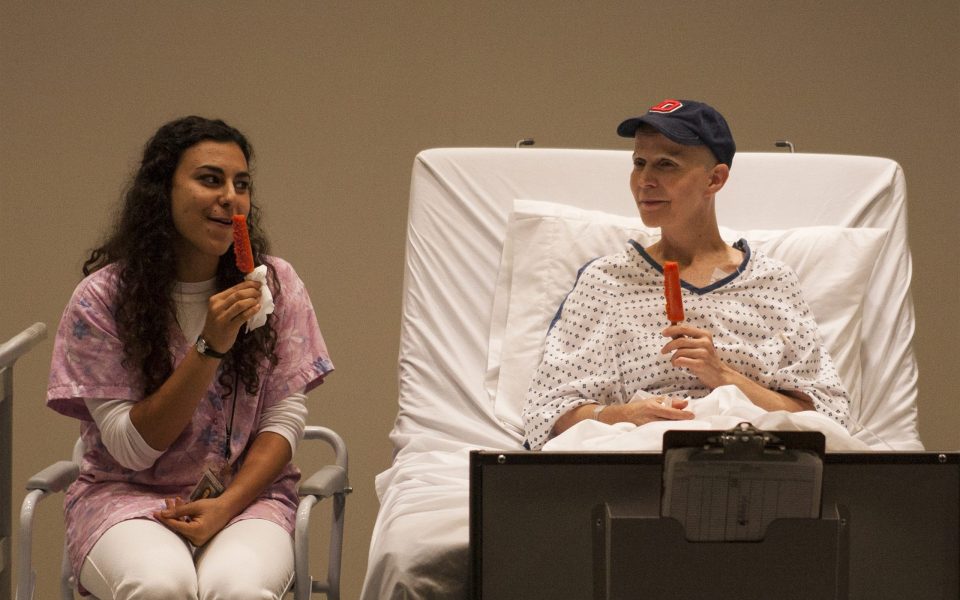Known for being a staunch intellectual, Vivian Bearing only wants kindness in the face of death.
by Daniel Wirtheim
The words of 17th Century poet John Donne are projected onto the main stage, casting the silhouette of a frail and dying Vivian Bearing, who sporadically lectures on the genius of Donne’s metaphysical connection to death.
It’s a turning point for Bearing, who’s beginning to understand that the intelligence she’s worn like armor has kept her from embracing life’s lighter and sometimes more meaningful moments. It’s also the moment when Wit, presented by Baptist Hospital, draws the audience’s first tears.
Kate Goehring plays the demanding role of Vivian Bearing, a distinguished professor of metaphysical literature diagnosed with stage IV metastatic ovarian cancer. She wears a baseball hat and clinical gown throughout the entire one-act play. Her hair and eyebrows are shaved, leaving the focus on her soft blue eyes that alone tell a story of suffering.
She addresses the audience as if lecturing a class of undergrads. Like the poetry of Donne that has become her life’s work, her speech is full of meta moments. She tells us that one scene is not long enough, that this is just a play and that she’s going to die in the end.
[pullquote]Visit the Triad Stage website for showtimes and tickets. [/pullquote]At times Goehring’s performance seems a little forced, especially in the beginning when she calls on audience support. But it goes to illustrate the awkward nature of being alone in a cancer treatment clinic. And once Goehring gets deeper into the narrative it’s clear that she’s done her homework. Her fever-chills are hyper-real and moments of agonizing pain are compelling, often terrifying. But it’s the words of Margaret Edson, the playwright who won a Pulitzer Prize for Wit in 1999, that give Bearing a self-reflective quality and lets some humor into her otherwise calculated speech.
Part of Wit’s genius comes from its ability to condense a lifetime of emotion into 90 minutes. The action is quick-paced and punctuated. We understand that the entire play takes place just a few moments before her death and that what we see, moments from childhood or lectures, is only a digression of thought that’s happening to her on the deathbed. Despite the bleak subject matter, use of space and time is be pretty fun in Wit.
In one exciting moment, hospital staff sweeps a lecturing Bearing up from a wheelchair to hospital beds across the stage as lights from above project CT-scans across her body. The rhythm builds until a mighty red laser hovers over her body like a beam of alien technology and Bearing squirms to deliver one of her lines on Donne’s reasoning with death.
Lighting Designer Norman Coates, whose resume includes Broadway credits and work on the Who’s Tommy tour, is on point with Wit. Fluorescent lights give the entire set a very clinical feel that contrasts exquisitely with the final scene, when a nude Bearing walks through an immaculate white light.
The technical direction plays a powerful role in Wit. There’s a lot of movement happening on a tiny stage and it’s all executed seamlessly. To shepherd her through the movement, Bearing has her IV station that she wheels around, a talisman of the death that surrounds her. But Wit, as the handbill suggests, is much more than a cancer play.
There’s a touching scene in which Vivian Bearing shares a Popsicle with Susie, her unassuming nurse, who is played with a human touch by the well-casted Mari Vial-Golden. It’s an oasis away from the cold world of the cancer clinic, where doctors are beginning to see Bearing’s terminal condition as research. The Popsicle moment with Susie is a pivotal moment for Bearing who after accepting the inevitability of death, focuses on reconciling with the isolation that her intellectual pursuits have imposed upon.
She revisits a lecture in which she humiliated one student and shot down another who suggested that Donne’s perception of the world was “too complex.” While the students sit frozen in time Bearing addresses the audience, commenting on how shrewd she had often been. Goehring a brings striking intensity to these moments that highlight the paradox of Bearing’s condition and the futility of her life as a staunch intellectual in the face of certain death.
She’s grappling with her paradox as one of Donne’s holy sonnets casts a silhouette of her frail and dying form across the stage. She lingers for a bit, short of words for the first time since the play began.
“All we can do is disappear,” she finally says.
Join the First Amendment Society, a membership that goes directly to funding TCB‘s newsroom.
We believe that reporting can save the world.
The TCB First Amendment Society recognizes the vital role of a free, unfettered press with a bundling of local experiences designed to build community, and unique engagements with our newsroom that will help you understand, and shape, local journalism’s critical role in uplifting the people in our cities.
All revenue goes directly into the newsroom as reporters’ salaries and freelance commissions.


Leave a Reply